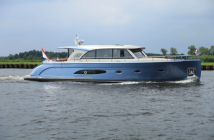But on a twin-screw vessel with propellers on each corner, docking a boat with one engine out of commission would test your docking skills to the max. After lots of trial and error, we discovered two factors which would make or break this docking scenario.
First, you needed to keep forward momentum going with an offset screw so you could steer straight. On a power boat, her rudders are much smaller than on a sailboat, so we needed even more speed than usual for positive steerage.
Second, favor a slip on the same side as the hand of the propeller*. Vessels with two engines carry a right-hand prop on the starboard corner and a left-hand prop on the port corner. If we have only the starboard engine working, we would look for an empty slip on the right side of the canal.
We would first make sure we had enough speed to steer the boat straight; then click in and out of forward gear just enough to keep forward momentum going. Two boat lengths away from the slip, we shifted into neutral gear.
Once the outer slip piling was close to her pivot point, the skipper gave the engine a half-second shot of reverse propulsion. Backing the starboard engine created a lot of prop-walk, and the bow pivoted to starboard and into the slip.
The crew draped the eyes of the after bow (or after quarter) springs onto the outer pilings to stop forward momentum. Not the prettiest docking in the world, but controlled and repeatable in an emergency.
If you have a right-hand propeller, you can use this same technique to assist you in a sharp turn, or even if you started the turn a bit too late. On a sailboat with a left-hand prop, the sharpest turns will be to port.
In the illustration above, our boat has a right-hand propeller. When the outermost piling is close to the boat’s natural pivot point, we give a quick burst of reverse propulsion (1). This kicks the stern to port and forward momentum carries the boat into the slip (2). Put over at least one after-bow or after-quarter spring line to stop the boat’s forward progress (3).
You may find you need one, two, or more half-second bursts in quick succession to make the turn. Practice this technique in different conditions of wind or current to understand your sailboat’s turning and handling characteristics. Read more:




